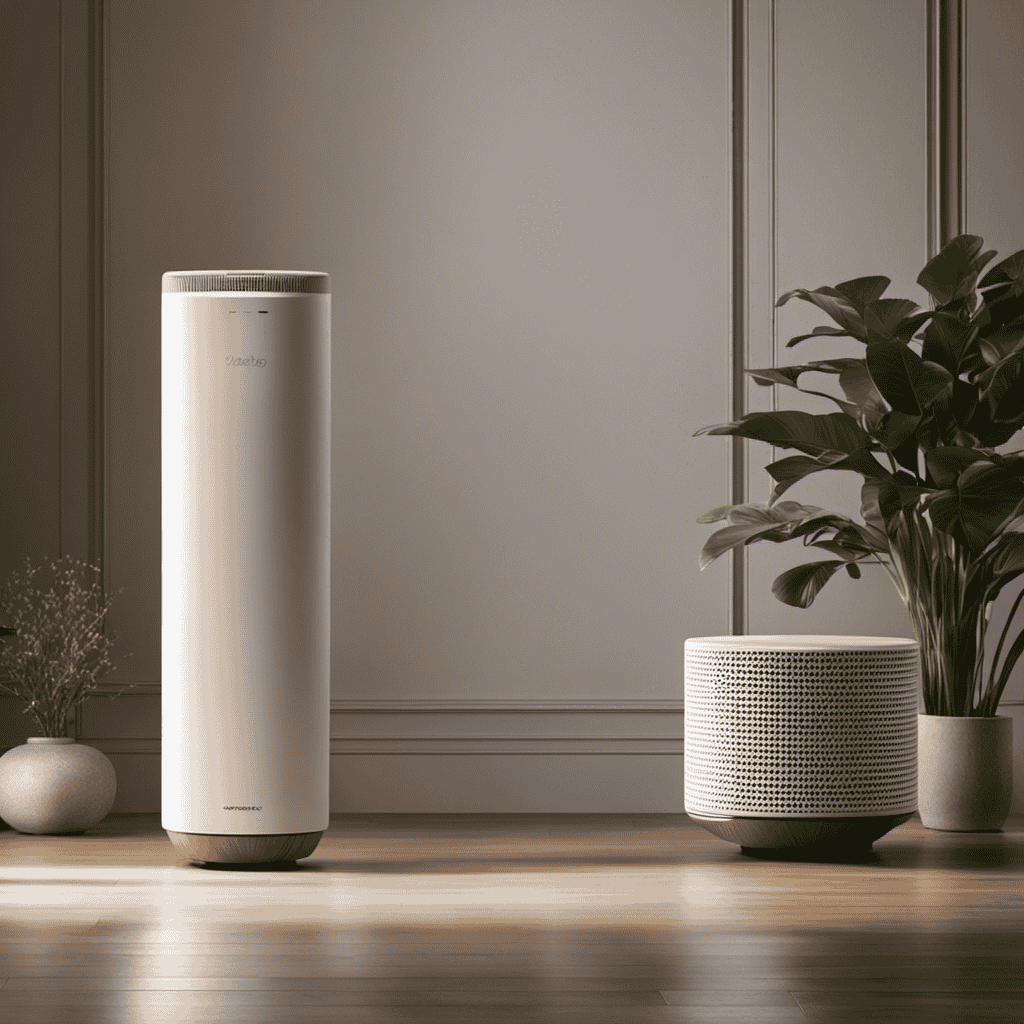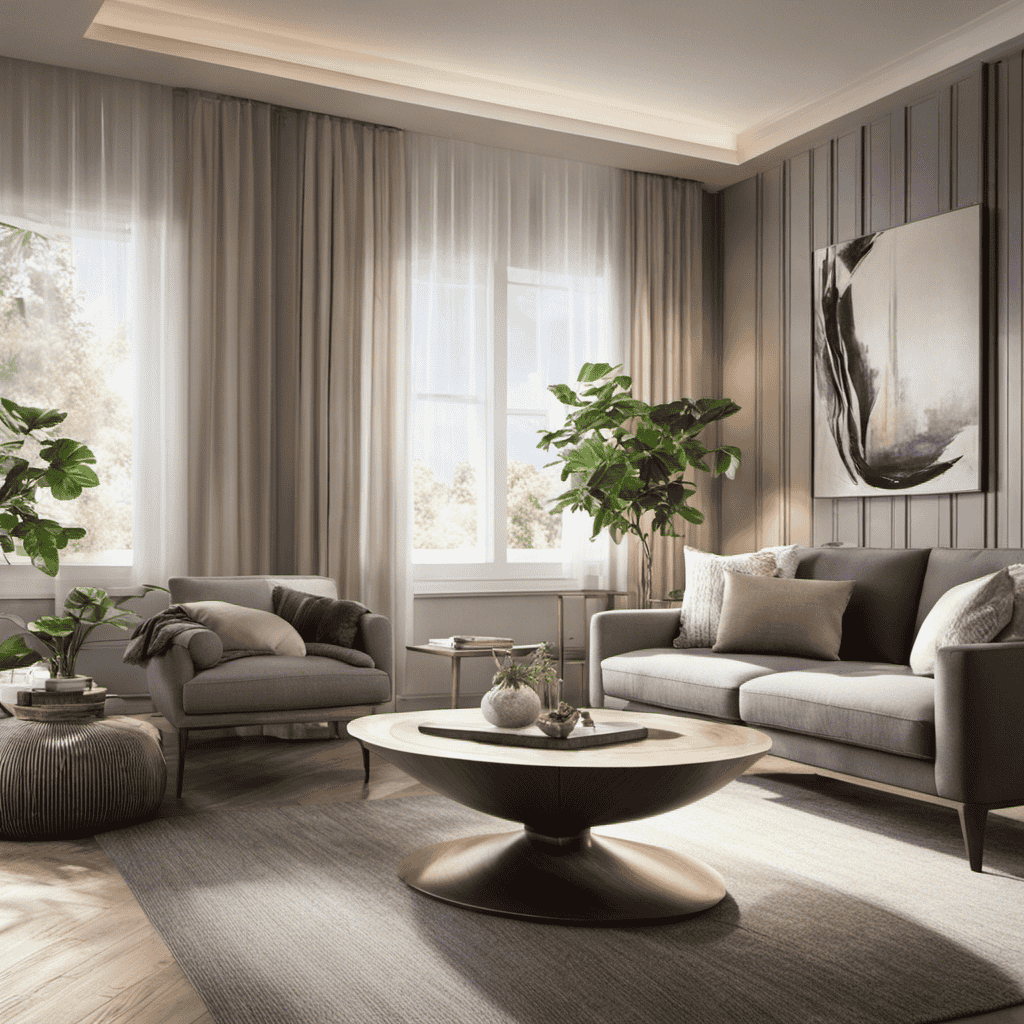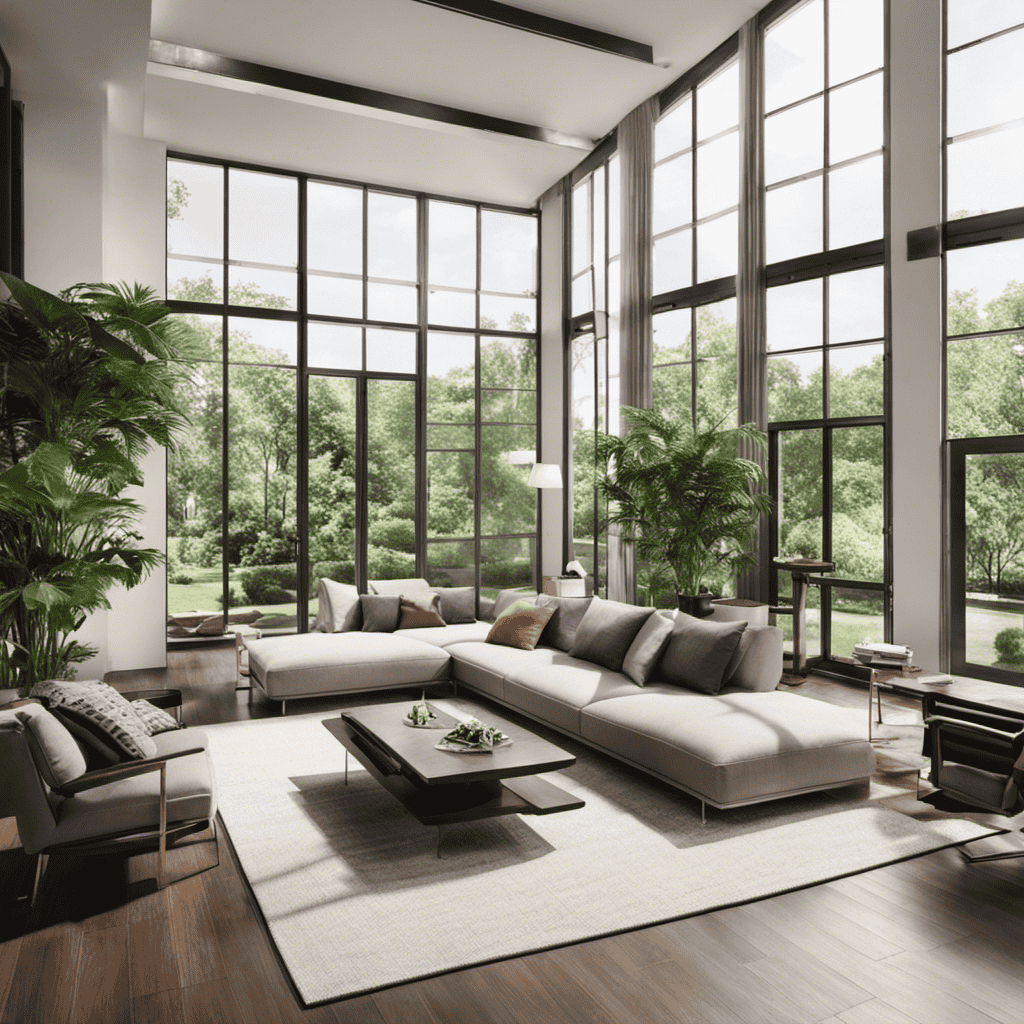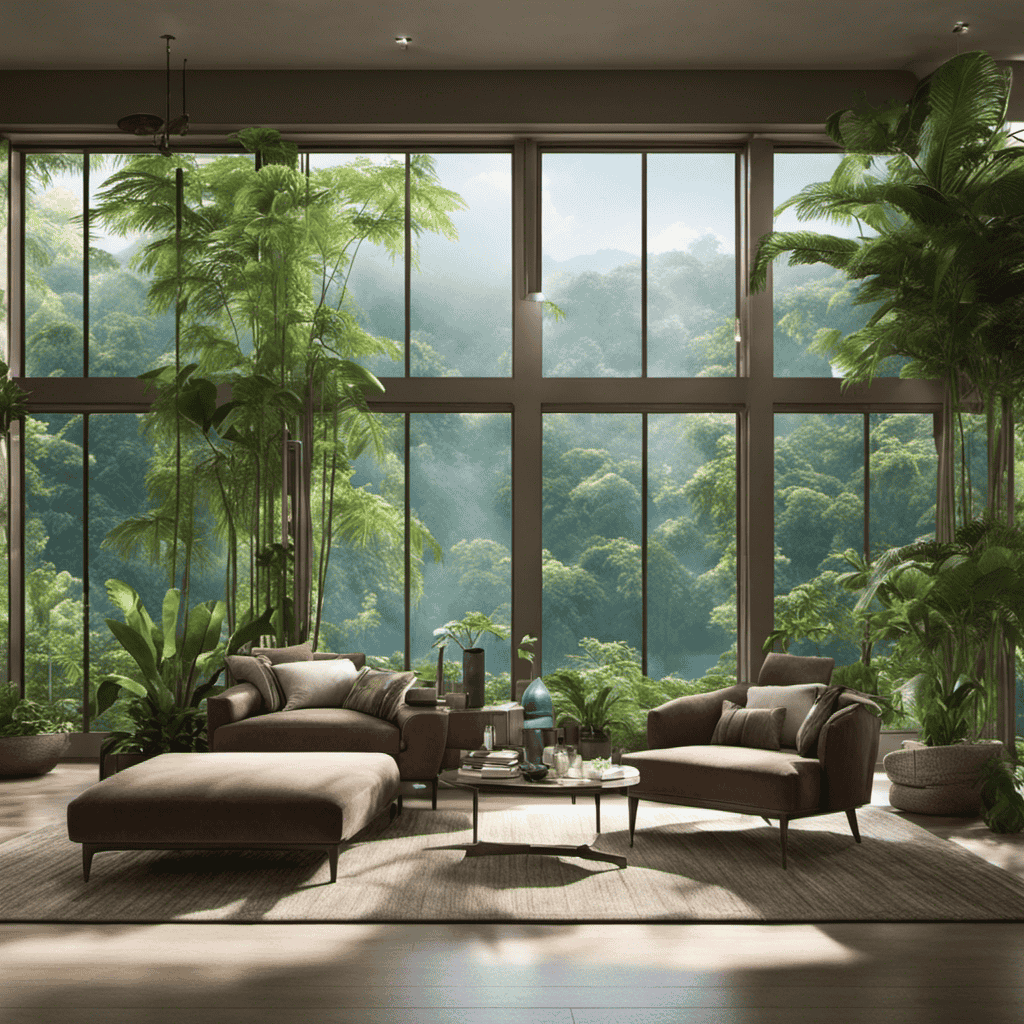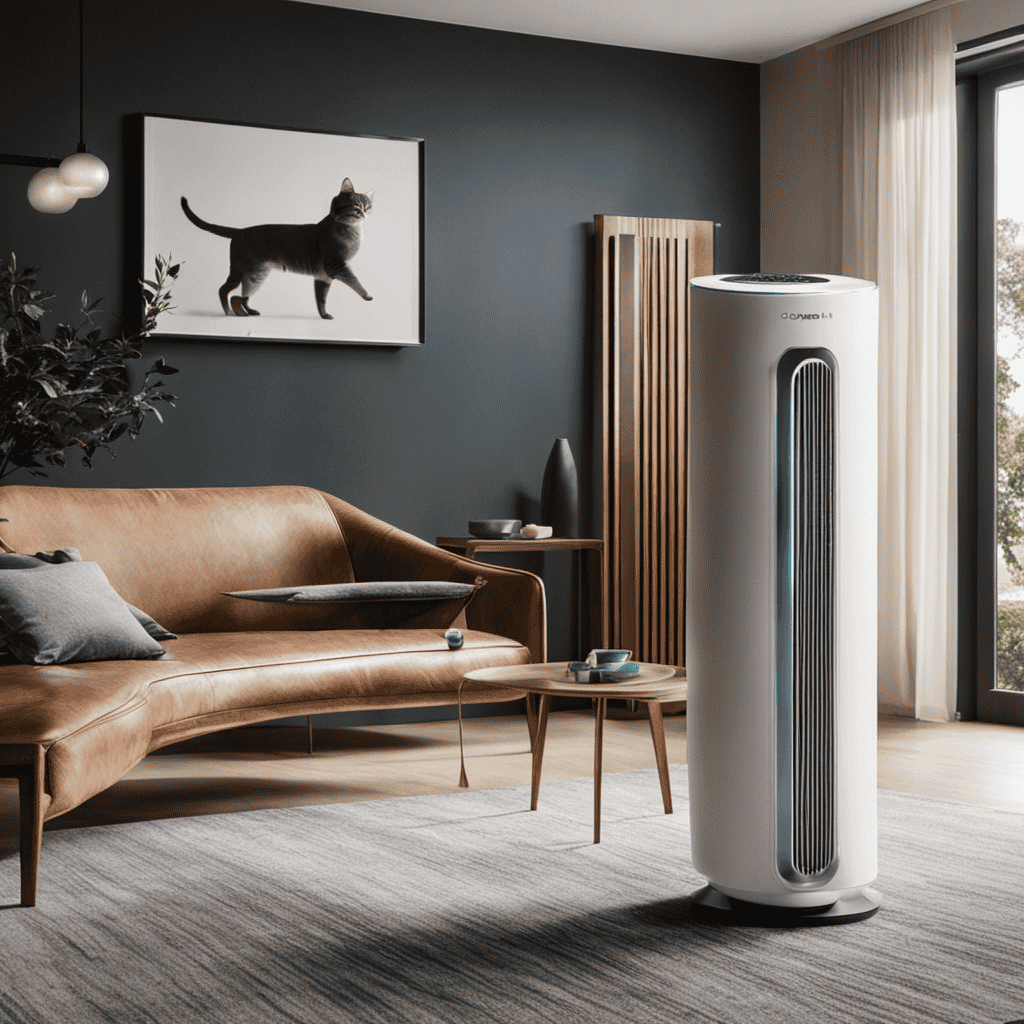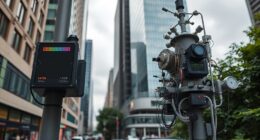Being a person with allergies, I understand the struggle of constantly fighting the air. That’s why I chose to buy an air purifier. And I have to say, it has made a huge difference.
It’s like having a personal assistant that filters out all the unwanted particles and allergens, leaving me with clean and fresh air to breathe.
In this article, I’ll be diving into the different types of air purifiers, their benefits, and how they improve indoor air quality. So, let’s get started!
Key Takeaways
- Air purifiers remove contaminants and allergens from the air.
- They reduce the presence of indoor pollutants like dust and pet dander.
- Air purifiers can eliminate unpleasant odors.
- They capture particles like dust, pollen, and mold spores.
Types of Air Purifiers
There are different types of air purifiers available in the market. When it comes to air purifier maintenance, it’s important to consider the specific type you have.
For example, if you have a HEPA (High-Efficiency Particulate Air) filter purifier, you’ll need to regularly clean or replace the filter to ensure its effectiveness. Some purifiers also come with a pre-filter that traps larger particles, which can be cleaned or replaced as well.
As for noise levels, it’s worth noting that some air purifiers can be quite loud, especially those with powerful fans. However, many manufacturers have made improvements in recent years to reduce noise levels, so you can find quieter options if noise is a concern for you.
Benefits of Using an Air Purifier
To improve the quality of the air you breathe, using an air purifier can provide several benefits.
Air purifiers work by removing contaminants and allergens from the air, helping to create a cleaner and healthier indoor environment.
One of the key benefits of using an air purifier is that it can help to reduce the presence of indoor pollutants, such as dust, pet dander, and pollen.
Additionally, air purifiers can also help to eliminate unpleasant odors, making your home or office smell fresher.
It’s important to note that while air purifiers are effective, they should not be seen as a substitute for proper ventilation and maintenance.
Regular maintenance, such as cleaning or replacing filters, is crucial to ensure the optimal performance of your air purifier.
By incorporating indoor plants and proper air purifier maintenance, you can further enhance the air quality in your space.
Now, let’s explore how air purifiers improve indoor air quality.
How Air Purifiers Improve Indoor Air Quality
Improve the quality of the air you breathe by understanding how air purifiers enhance indoor air quality.
Air purifiers are designed to filter out impurities and contaminants from the air, making it cleaner and healthier to breathe. They work by capturing particles like dust, pollen, pet dander, and even mold spores, preventing them from circulating in the indoor environment.
Air purifiers can also remove harmful substances such as volatile organic compounds (VOCs) and odors, improving the overall freshness of the air.
While air purifiers are effective on their own, they can be even more beneficial when combined with other methods like using indoor plants and natural ventilation.
Indoor plants can help absorb certain pollutants and release oxygen, while natural ventilation allows fresh outdoor air to circulate and reduce the concentration of indoor pollutants.
Common Air Pollutants Removed by Air Purifiers
Air purifiers can effectively remove common air pollutants, such as dust, pollen, pet dander, and mold spores. These pollutants can cause allergies and respiratory issues, so it’s important to reduce their presence in indoor spaces.
Pet dander, for example, is a common allergen that can trigger symptoms in those with allergies or asthma. Air purifiers with HEPA filters are particularly effective in removing pet dander from the air. HEPA stands for High-Efficiency Particulate Air, and these filters can trap particles as small as 0.3 microns in size.
Understanding HEPA Filters in Air Purifiers
Understanding how HEPA filters work in air purifiers is essential for choosing the right one for your needs. HEPA stands for High Efficiency Particulate Air, and these filters are designed to capture and remove airborne particles as small as 0.3 microns. This includes dust, pollen, pet dander, mold spores, and even some bacteria and viruses. The benefits of HEPA filters in air purifiers are numerous. They improve indoor air quality, reduce allergens and asthma triggers, and create a cleaner and healthier living environment. With the importance of air purification becoming increasingly recognized, investing in an air purifier with a HEPA filter is a wise choice. Here is a table summarizing the benefits of HEPA filters:
| Benefits of HEPA Filters in Air Purifiers |
|---|
| Removes dust and allergens |
| Reduces asthma triggers |
| Captures pet dander and hair |
| Eliminates mold spores |
| Filters out bacteria and viruses |
The Role of Activated Carbon Filters in Air Purifiers
When it comes to air purifiers, activated carbon filters play a crucial role. They are designed to trap and absorb harmful pollutants and chemicals, such as volatile organic compounds (VOCs), formaldehyde, and tobacco smoke. By removing these toxins, activated carbon filters help create a healthier and more pleasant environment, free from unpleasant odors and harmful particles. They also contribute to improving indoor air quality by reducing the presence of allergens and irritants. In summary, activated carbon filters are an essential component of any air purification system.
Filtering Out Toxins
You can easily see the benefits of using an air purifier by noticing how it effectively filters out toxins from the air you breathe.
Maintaining your air purifier is crucial to ensure it continues to function optimally. Regularly cleaning or replacing the filters is essential for proper air filtration. Dust, pet dander, pollen, and other airborne particles can accumulate on the filters over time, reducing their effectiveness.
Additionally, a dirty filter can potentially lead to the release of trapped pollutants back into the air. By properly maintaining your air purifier, you can ensure that it continues to provide you with clean and fresh air.
Clean air is vital for our health and wellbeing, as it helps reduce the risk of respiratory issues, allergies, and other health problems caused by poor air quality.
Eliminating Odors Effectively
Eliminating odors effectively can be achieved by regularly cleaning or replacing the filters in your air purifier. Accumulated particles can contribute to unpleasant smells in the air.
Air purifiers are equipped with advanced purifying technology. This technology helps to remove various airborne particles, including allergens, dust, and pet dander. These particles can get trapped in the filters over time, leading to a buildup of odor-causing substances.
By cleaning or replacing the filters, you can ensure that your air purifier continues to effectively eliminate odors and maintain a fresh, clean scent in your home.
Some air purifiers also come with additional features, such as activated carbon filters. These filters are specifically designed to target and remove odors from the air.
It is important to follow the manufacturer’s instructions on filter maintenance to ensure optimal performance and scent elimination.
Improving Indoor Air Quality
After learning about how air purifiers can effectively eliminate odors, let’s now delve into how they can improve indoor air quality.
Indoor air pollution is a serious concern as it can have detrimental effects on our health. Air purifiers work by filtering out harmful pollutants and particles from the air, ensuring that the air we breathe is clean and safe.
Here are three ways air purifiers can help improve indoor air quality:
-
Removal of allergens: Air purifiers can capture and remove common allergens such as pollen, pet dander, and dust mites, reducing the risk of allergic reactions and respiratory issues.
-
Elimination of volatile organic compounds (VOCs): Air purifiers equipped with activated carbon filters can effectively remove harmful VOCs emitted by household products, paints, and cleaning chemicals, safeguarding our health.
-
Reduction of airborne bacteria and viruses: Some air purifiers are equipped with UV-C light technology, which can help inactivating airborne bacteria and viruses, further enhancing indoor air quality and reducing the risk of infections.
UV-C Light Technology in Air Purifiers
Using UV-C light technology, air purifiers can effectively kill germs and bacteria in the air. UV-C light is a type of ultraviolet light that has been proven to be highly effective in disinfecting the air. It works by damaging the DNA and RNA of microorganisms, preventing them from reproducing and causing harm. However, it is important to note that UV-C light can also be harmful to humans if not used properly. Therefore, it is crucial to ensure that air purifiers with UV-C light technology have safety features such as automatic shut-off when the device is opened. Additionally, it is recommended to follow the manufacturer’s instructions for safe usage. Overall, when used correctly, UV-C light technology in air purifiers can be a powerful tool in improving indoor air quality and reducing the spread of germs and bacteria.
| Pros | Cons | Safety Tips |
|---|---|---|
| Kills germs and bacteria effectively | Can be harmful to humans if not used properly | Follow manufacturer’s instructions |
| Reduces the spread of infections | May not eliminate all types of microorganisms | Ensure automatic shut-off when device is opened |
| Improves indoor air quality | Requires regular maintenance and bulb replacement | Place air purifier in an area away from direct exposure to humans |
Ionizers and Ozone Generators in Air Purifiers
Ionizers and ozone generators, when used in air purifiers, can help to improve indoor air quality by reducing airborne particles and odors. However, it is important to consider the safety implications of using these technologies.
Here are three key points to keep in mind regarding ionizers and ozone generators in air purifiers:
-
Ionizers: These devices release negatively charged ions into the air, which attach to airborne particles and cause them to fall to the ground. While ionizers can effectively remove particles from the air, they can also produce ozone as a byproduct, which can be harmful in high concentrations.
-
Ozone generators: These devices intentionally produce ozone to eliminate odors and kill bacteria. However, ozone can be irritating to the respiratory system, especially for people with asthma or other respiratory conditions. It is crucial to ensure that ozone levels remain within safe limits when using ozone generators.
-
Safety precautions: When using air purifiers with ionizers or ozone generators, it is essential to follow the manufacturer’s instructions, maintain proper ventilation, and regularly monitor ozone levels to ensure a safe and healthy indoor environment.
Understanding the safety considerations associated with ionizers and ozone generators in air purifiers is crucial for making informed decisions about improving indoor air quality.
Now let’s transition into the next section, which discusses air purifiers specifically designed for allergies and asthma.
Air Purifiers for Allergies and Asthma
When considering air purifiers for allergies and asthma, it’s important to choose a model that effectively filters out allergens and irritants.
Air purifiers designed for respiratory health can greatly benefit individuals with allergies and asthma by removing airborne particles that trigger symptoms. These purifiers use HEPA filters, which are capable of capturing tiny particles like pollen, dust mites, pet dander, and mold spores.
They also help alleviate seasonal allergies by reducing the amount of outdoor allergens that enter your home. With their powerful filtration systems, air purifiers for allergies and asthma create a cleaner indoor environment, allowing you to breathe easier and reduce the frequency and severity of respiratory symptoms.
Now, let’s move on to the next section about air purifiers for pet owners.
Air Purifiers for Pet Owners
If you have pets at home, it’s important to choose an air purifier that effectively filters out pet dander and odors. As a pet owner myself, I understand the struggle of dealing with pet hair and dander in the air.
Here are three key features to look for in air purifiers specifically designed for pet owners:
-
HEPA Filter: Look for an air purifier with a high-efficiency particulate air (HEPA) filter. This type of filter can effectively capture microscopic pet dander particles, reducing allergens in the air.
-
Activated Carbon Filter: An activated carbon filter is great for eliminating pet odors. It absorbs and neutralizes unpleasant smells, leaving your home smelling fresh.
-
Pre-Filter: A pre-filter is essential for trapping larger pet hair and fur particles. It helps prolong the life of the HEPA filter by preventing it from clogging too quickly.
Choosing an air purifier with these features will ensure that you can enjoy clean and fresh air while keeping your furry friends happy and healthy.
Air Purifiers for Smokers and Odor Elimination
One important feature to consider for air purifiers designed for smokers and odor elimination is an activated carbon filter. This type of filter is highly effective in reducing and eliminating odors caused by smoking.
When smoke passes through the carbon filter, the activated carbon traps and absorbs the smoke particles, neutralizing the unpleasant smell. Not only does it remove smoke odors, but it also helps to eliminate other common household odors, such as cooking smells, pet odors, and musty odors.
The activated carbon filter works by adsorption, which means it attracts and holds the odor molecules onto its surface. This ensures that the air in your home remains fresh and odor-free, creating a healthier and more comfortable living environment for smokers and non-smokers alike.
Air Purifiers for Dust and Pollen
When it comes to allergies and air quality, filtration plays a crucial role.
As someone who suffers from allergies, I understand the importance of having clean air to breathe.
Air purifiers with effective filtration systems can help remove allergens such as dust and pollen, improving the overall air quality and reducing allergy symptoms.
Allergies and Air Quality
You can improve your allergies and air quality by using an air purifier. Air purifiers are designed to remove allergens and pollutants from the air, which can help alleviate respiratory issues and reduce the symptoms of seasonal allergies.
Here are three ways in which air purifiers can benefit your respiratory health and help with seasonal allergies:
-
Filter out allergens: Air purifiers are equipped with filters that can capture and remove common allergens such as pollen, dust mites, pet dander, and mold spores. This can significantly reduce the presence of these allergens in your home, providing you with cleaner and healthier air to breathe.
-
Remove airborne pollutants: Air purifiers can also eliminate various airborne pollutants, including smoke, chemical fumes, and volatile organic compounds (VOCs). These pollutants can irritate the respiratory system and trigger allergies, so removing them from the air can greatly improve your respiratory health.
-
Create a clean environment: By continuously filtering and circulating the air, air purifiers help create a clean and fresh environment in your home. This can reduce the overall allergen load, making it easier for allergy sufferers to breathe and reducing the severity of allergic reactions.
Benefits of Filtration
To improve your respiratory health and alleviate allergy symptoms, consider the benefits of filtration in an air purifier. Clean air is crucial for maintaining good health, and air purification plays a vital role in ensuring that the air we breathe is free from pollutants and allergens.
Filtration is a key component of air purifiers, as it effectively traps and removes particles from the air, such as dust, pollen, pet dander, and mold spores. By removing these contaminants, air purifiers help create a healthier indoor environment and reduce the risk of respiratory issues.
The importance of air purification cannot be overstated, especially for individuals with allergies or respiratory conditions. Investing in an air purifier with effective filtration can greatly improve the quality of the air you breathe, providing numerous benefits for your overall well-being.
Now, let’s transition into the subsequent section about ‘air purifiers for mold and mildew’.
Air Purifiers for Mold and Mildew
If you’re dealing with mold and mildew, an air purifier can help to eliminate these allergens and improve the air quality in your home. Here are three ways air purifiers can help with mold and mildew:
-
Filtration: Air purifiers equipped with HEPA filters can capture mold spores and prevent them from circulating in the air. These filters are designed to trap particles as small as 0.3 microns, ensuring that mold spores are effectively removed.
-
UV-C Light: Some air purifiers use ultraviolet (UV-C) light technology to kill mold and mildew. UV-C light damages the DNA of mold spores, preventing them from reproducing and spreading further.
-
Activated Carbon Filters: Air purifiers with activated carbon filters can help remove the musty odor associated with mold and mildew. These filters are effective in absorbing volatile organic compounds (VOCs) and other odorous substances.
Air Purifiers for VOCs and Chemicals
When dealing with VOCs and chemicals, an air purifier with activated carbon filters can effectively remove these harmful substances from the air in your home. These air purifiers are specifically designed to target and eliminate formaldehyde and volatile organic compounds (VOCs), which can be found in various household products and materials. The activated carbon filters in these purifiers have a large surface area, allowing them to adsorb and trap these chemicals, preventing them from recirculating in the air. This helps improve the indoor air quality and reduce the potential health risks associated with exposure to VOCs and formaldehyde. Here is a table showcasing some popular air purifiers for VOCs and formaldehyde:
| Air Purifier Model | Features | Coverage Area |
|---|---|---|
| Model A | HEPA filter, activated carbon filter | Up to 300 sq. ft. |
| Model B | True HEPA filter, VOC sensor | Up to 500 sq. ft. |
| Model C | Multiple filters, auto mode | Up to 700 sq. ft. |
Investing in an air purifier specifically designed to target VOCs and chemicals is a proactive step towards creating a healthier indoor environment for you and your family.
How to Choose the Right Air Purifier for Your Needs
When it comes to choosing the right air purifier for your needs, there are several key factors that should be taken into consideration.
These factors include the size of the room, the specific pollutants you want to target, and your budget.
Key Factors for Selection
To find the right air purifier for you, consider key factors such as room size, CADR ratings, and the type of filtration system it uses. These factors play a crucial role in determining the effectiveness of the air purifier in improving your indoor air quality.
-
Room size: It is important to choose an air purifier that is suitable for the size of the room you plan to use it in. A purifier that is too small may not be able to effectively clean the air, while one that is too big may be unnecessarily expensive and consume more energy.
-
CADR ratings: Clean Air Delivery Rate (CADR) is a measure of how well an air purifier can remove airborne particles such as dust, pollen, and smoke. Higher CADR ratings indicate a more efficient air purifier.
-
Filtration system: Different air purifiers use various types of filtration systems, such as HEPA filters, activated carbon filters, or electrostatic precipitators. Understanding the type of filtration system will help you determine the purifier’s ability to capture specific pollutants.
Considering these factors will ensure that you select an air purifier that meets your specific needs and provides cleaner and healthier indoor air.
Targeted Air Purification Solutions
One option for targeted air purification is using an air purifier with a HEPA filter. These air purifiers are designed to capture and remove small particles from the air, such as dust, pollen, pet dander, and mold spores. They work by pulling in air and passing it through a series of filters, including the HEPA filter, which is capable of trapping particles as small as 0.3 microns. This makes them an effective solution for improving indoor air quality in small spaces, such as bedrooms, offices, or nurseries. Additionally, some air purifiers also feature additional technologies, like activated carbon filters or UV-C light, which can help to remove odors and kill bacteria and viruses. When choosing an air purifier for a small space, it is important to consider the room size, the CADR (Clean Air Delivery Rate), and the noise level of the device.
| Pros | Cons | Suitable for |
|---|---|---|
| Removes small particles | Does not remove gases or VOCs | Small bedrooms |
| Improves indoor air quality | Requires filter replacement | Offices |
| Can remove odors | Some models can be noisy | Nurseries |
| Kills bacteria and viruses | Higher initial cost | Small living areas |
| Compact and portable | Limited coverage area |
Frequently Asked Questions
Do Air Purifiers Help With Reducing the Spread of Airborne Viruses, Such as Covid-19?
Air purifiers can help reduce the spread of airborne viruses like COVID-19 by filtering out particles and microorganisms. They also eliminate pet dander and indoor air pollution, improving overall air quality and promoting a healthier environment.
Can Air Purifiers Eliminate All Types of Odors, Including Strong Cooking Smells?
Air purifiers work wonders, eliminating all types of odors. They tackle those strong cooking smells and even pet odors. Plus, they’re effective at getting rid of cigarette smoke, leaving your air fresh and clean.
How Often Should the Filters in an Air Purifier Be Replaced?
Air purifier maintenance is important for optimal performance. Filters should be replaced regularly to ensure clean air. The lifespan of an air purifier filter depends on usage and the manufacturer’s recommendations.
Are There Any Potential Health Risks Associated With Using an Air Purifier?
Potential side effects of using an air purifier include dryness and irritation in the throat and eyes. However, long-term effects are generally positive, as air purifiers can help reduce allergens and improve overall air quality.
Can Air Purifiers Help With Reducing the Symptoms of Hay Fever or Other Seasonal Allergies?
Air purifiers can help reduce symptoms of hay fever and other seasonal allergies by removing allergens like pollen, dust, and pet dander from indoor air. They improve indoor air quality and provide relief from allergy symptoms.
Conclusion
In conclusion, air purifiers are a game-changer when it comes to improving indoor air quality. They work tirelessly to remove common air pollutants like dust, pollen, mold, and chemicals, ensuring cleaner and healthier air for you and your loved ones.
Just like a superhero fighting off invisible enemies, air purifiers silently and efficiently combat the hidden threats in our homes.
So, why not invest in an air purifier and let it be your sidekick in the battle for fresh air?
Remember, cleaner air means a happier and healthier life.
